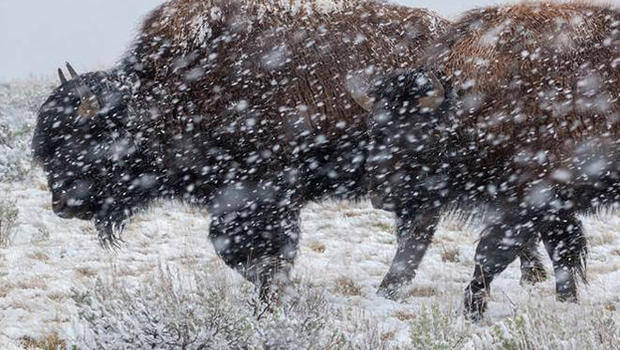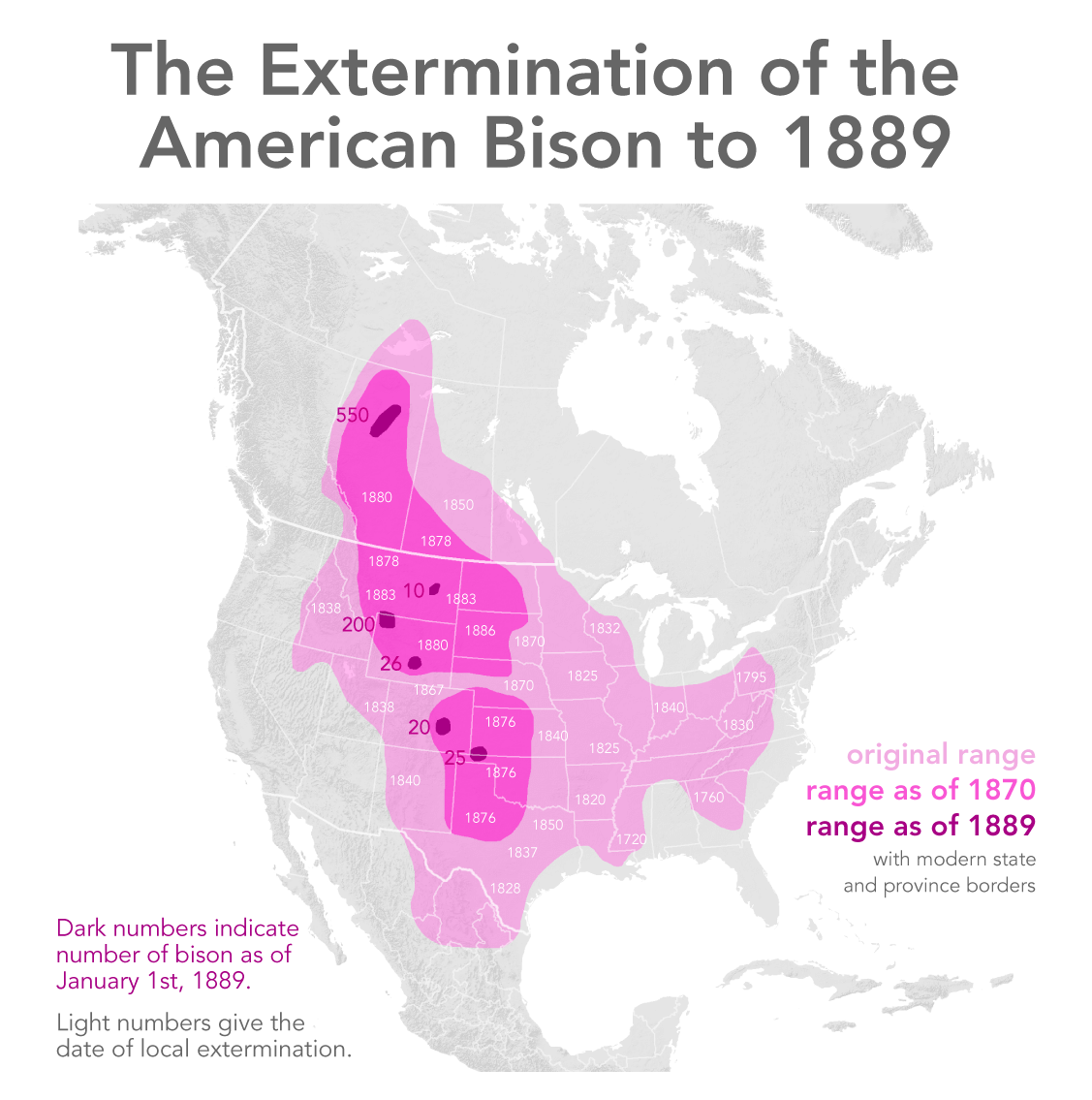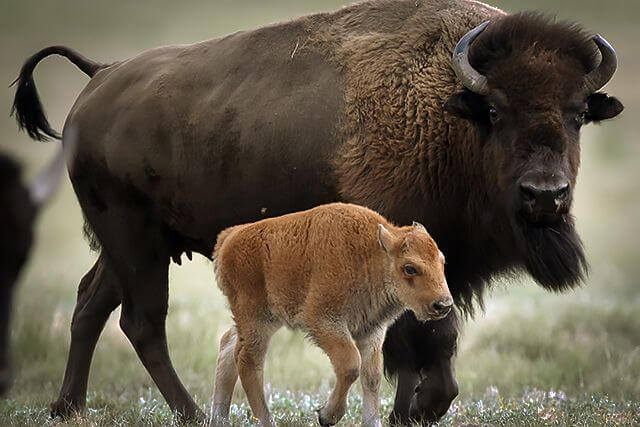
By “Sunday Morning” a videographer Judy Lehmberg.
Just imagine what the North American plains looked like when Lewis and Clark first saw them — no highways, no cars, no power lines, only the sound of the wind with mile after mile of grasses, bison, pronghorn antelope and prairie dogs. Those days are obviously gone, but today there are still places where large populations of bison can be found.
Yellowstone National Park currently holds the largest bison numbers, with a population of over 4,500.
Two hundred years ago, more than 30 million bison ranged over much of what is now the United States. Today there are only remnant populations in several protected areas, such as Yellowstone, several federally and state protected areas, and a number of private ranches. The American bison is ecologically extinct. Its population is now too small to fill the role it once played in trimming grasses, “ploughing” the ground with its hoofs, fertilizing the soil with manure, and creating bison wallows. Several species of grasses and at least one bird, the brown-headed cowbird, evolved with bison.
In 2016 President Obama signed a law making bison the national mammal of the United States. Conservationists, bison ranchers and tribal groups were all instrumental in passing this legislation. Native Americans have long advocated for protecting and increasing bison populations, as the history of both is so closely intertwined.
American and European bison are the only species left of the eight species known from fossils. American bison are classified into two subspecies: the plains bison (Bison bison bison), formerly found in much of North America, and the wood bison (Bison bison athabascae), found in Canada‘s Wood Buffalo National Park. The history of bison in the New World shows several species existed including B. antiquus, the ancient bison and the predecessor of present-day North American bison. Fossils of the ancient bison, a 7.5-foot-tall, 3,500-pound animal, have been found with Folsom points embedded in their bones, proving that people were hunting them over 11,000 years ago. No one knows what influence if any, Native Americans had on species such as mastodons and ancient bison, but we do know many mammal extinctions occurred during the Late Pleistocene. Modern North American bison arose from B. antiquus, and this is the species the Plains Indians depended upon. Before Spanish explorers brought horses to North America in1519, the indigenous peoples killed bison by driving them over “buffalo jump” cliffs and then finishing them off with spears and clubs. Some buffalo jumps are known today, and artefacts from ancient buffalo harvests are still being found.
Indians probably first got horses around 1650, from Santa Fe, New Mexico traders. Horses then spread from there to Nebraska by 1680, and the upper Missouri River basin by 1750. While Eastern tribes used horses for bison hunts, they were not nomadic and stuck to their maize growing and permanent lodges. In contrast, Western tribes were more nomadic. They travelled long distances following the bison herds. They used horse-drawn travois to haul their bison skin tipis, a dwelling unique to the plains people. Once they obtained horses, the Plains tribes killed bison while mounted on horseback, rather than continue to use cliffs as buffalo jumps.

Plains tribes were always dependent on bison, before and after the acquisition of horses, and revered them in their religious ceremonies.
Between 30 to 60 million bison roamed the plains before 1800, but by 1890 only around 1,000 were left. Commercial buffalo hunting was encouraged by the U.S. Army as a way to cut the food supply from the Native Americans, and it worked. When a Pennsylvania tannery developed a method of curing buffalo hides so they could be used as commercial leather in 1871, hide prices jumped to $3.00 each. One county in Montana shipped 180,000 buffalo skins east in 1881 alone. Generals Sheridan and Sherman got their wish when hordes of hide hunters decimated buffalo herds. The bison were almost gone, and most Native Americans were on reservations.
The remnant wild bison were in Yellowstone and on some ranches, including Charles Goodnight’s ranch in Texas. Goodnight saved a small bison herd, and donated a few to Yellowstone. Only between 500 and 800 bison were on private lands, and around 50 in Yellowstone. Early efforts to protect the remaining bison included creating laws prohibiting shooting Yellowstone bison. President Theodore Roosevelt and William T. Hornaday formed the American Bison Society in 1905. Through donations, the 20,000-acre National Bison Range was purchased in Montana. Presently, that herd is managed at about 350 individuals, most descendants from the original founding group.

Today, there are about 500,000 bison in North America, largely on ranches. Many of these have some cattle genes, because they shared land with domestic livestock on those ranches — bison and domestic cattle can interbreed. About 19,000 bison are on state and federally-protected land and are more genetically pure.
Because of forward-thinking individuals like Theodore Roosevelt, the American bison, which almost went the way of the passenger pigeon, is alive and thriving on both public and private lands in some of its original habitats.
Judy Lehmberg is a former college biology teacher who now shoots nature videos.
For more info:
- Judy Lehmberg (Official site)
- Judy Lehmberg’s YouTube Channel
To watch extended “Sunday Morning” Nature videos click here!
Source: cbsnews
..
Read More: Other Native cattle
For More information and purchase on different indigenous breeds
Alambadi Cattle | Amrit Mahal Cattle | Bachaur cattle | Bargur Cattle | Gir Breed |Kasaragod Dwarf Cattle | Kherigarh Cattle | Krishna Valley cattle | Malnad Gidda Cattle | Mewati Breed | Ongole breed cattle | Ponwar Breed | Pulikulam Cattle | Umblachery Cattle | Vechur Cattle Breed
..
Read More: Native Dog breed
For More information on Indian native dog breeds.
Banjara Greyhound | Bully kutta mastiff | Chippiparai Hound | Gaddi Kutta mastiff | Indian Spitz | Jonangi breed | Kanni hound dog | Kombai/Combai hound dog | Mudhol Hound | Pandikona Hound | Rajapalayam Hound | Rampur Hound
..
Also Read : Other Blog
How to Recognise Native British Cattle Breeds | The American Bison | Recognized indigenous cattle breeds of India | List of Bos Indicus Breeds – Zebu Breed | First Domesticated Cattle in the World : Origin of Modern Cows Traced | 40 million cows to get Aadhaar like number at cost of Rs 50 crore in 1st phase : Budget 2018 | Registration of livestock/poultry breeds rises to 169: Govt | Chennai to host expo of indigenous native cattle breeds on Jan 6 and 7. | Kerala Sets up a special reproduction centre to help grow Vechur cattle population | Andhra pradesh well poised to become a seed hub, says Bill Gates | Using Cow Dung of Indigenous Breeds, This Farmer Makes Lakhs from Organic Papaya | Kampala to host 2017 livestock show | Cargill to plough millions into animal nutrition business in India | Supreme Court issues notice to Tamil Nadu government on PETA plea against jallikattu | Haryana govt plans PGs for cattle to boost milk production | Molecular Characterisation of Rathi and Tharparkar Indigenous Cattle (Bos indicus) | Embryo transfer technology to be used to carry out 440 embryo transfers in cattle in 9 days | ‘Rettamalai Ondikaruppu’ Temple Bull , is no more | Decline in indigenous cow breeds: NGT summons official | Maharashtra moos to boost desi/Indigenous cow varieties | Soon desi cow’s milk will be sold through medical stores: Warns Rajasthan minister | Telangana ties up with Brazil to improve Desi milk production | Project Mooo: supporting India’s dairy farmers with sustainable technology | Government allocates ₹2.5 cr. for protection of native cattle breeds | Project to preserve indigenous cattle – Karnataka.| Alanganallur was the most crowded village today in India! | Tamils Gathered in America, To show Support Jallikattu!! |